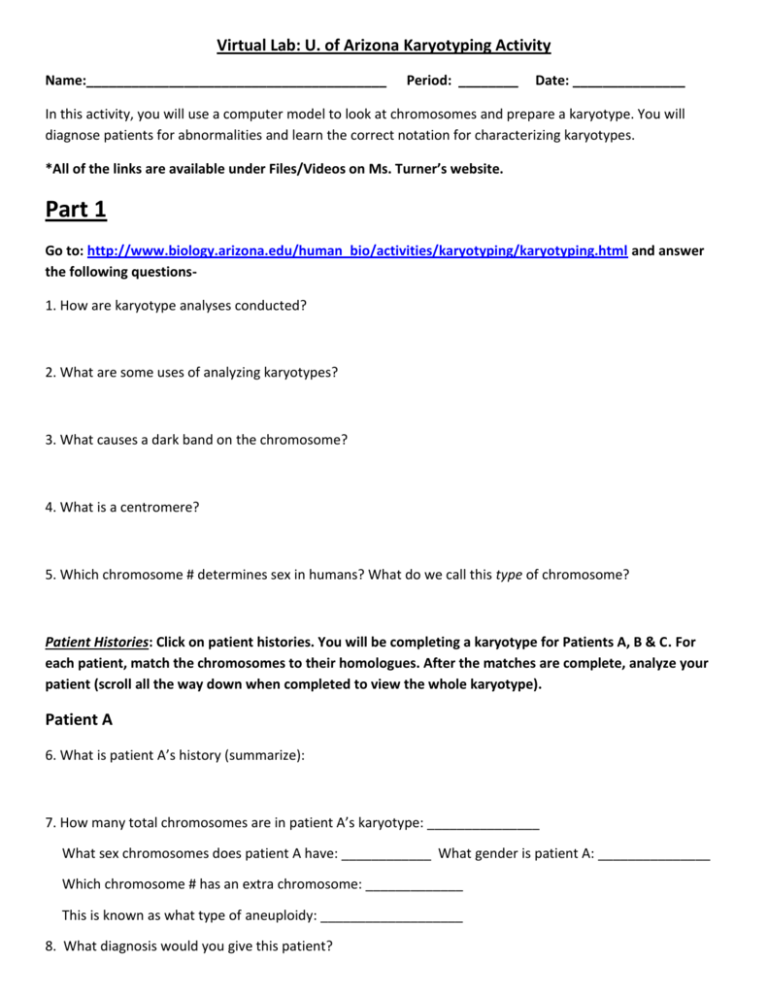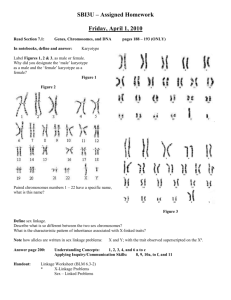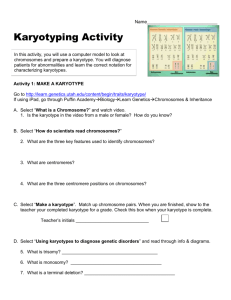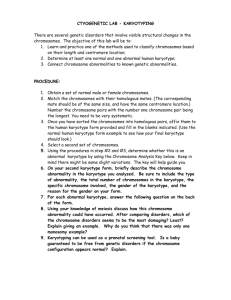
Virtual Lab: U. of Arizona Karyotyping Activity
Name:________________________________________
Period: ________
Date: _______________
In this activity, you will use a computer model to look at chromosomes and prepare a karyotype. You will
diagnose patients for abnormalities and learn the correct notation for characterizing karyotypes.
*All of the links are available under Files/Videos on Ms. Turner’s website.
Part 1
Go to: http://www.biology.arizona.edu/human_bio/activities/karyotyping/karyotyping.html and answer
the following questions1. How are karyotype analyses conducted?
2. What are some uses of analyzing karyotypes?
3. What causes a dark band on the chromosome?
4. What is a centromere?
5. Which chromosome # determines sex in humans? What do we call this type of chromosome?
Patient Histories: Click on patient histories. You will be completing a karyotype for Patients A, B & C. For
each patient, match the chromosomes to their homologues. After the matches are complete, analyze your
patient (scroll all the way down when completed to view the whole karyotype).
Patient A
6. What is patient A’s history (summarize):
7. How many total chromosomes are in patient A’s karyotype: _______________
What sex chromosomes does patient A have: ____________ What gender is patient A: _______________
Which chromosome # has an extra chromosome: _____________
This is known as what type of aneuploidy: ___________________
8. What diagnosis would you give this patient?
Patient B
9. What is patient A’s history (summarize):
10. How many total chromosomes are in patient A’s karyotype: _______________
What sex chromosomes does patient A have: ____________ What gender is patient A: _______________
Which chromosome # has an extra chromosome: _____________
This is known as what type of aneuploidy: ___________________
11. What diagnosis would you give this patient?
Patient C
12. What is patient A’s history (summarize):
13. How many total chromosomes are in patient A’s karyotype: _______________
What sex chromosomes does patient A have: ____________ What gender is patient A: _______________
Which chromosome # has an extra chromosome: _____________
This is known as what type of aneuploidy: ___________________
14. What diagnosis would you give this patient?
Part 2
Go to: http://learn.genetics.utah.edu/content/chromosomes/ and click How Do Scientists Read
Chromosomes
15. What are the 3 key features used to read chromosomes?
16. What are centromeres used for?
17. Sketch or describe: metacentric, submetacentric, acrocentric
Go back to: http://learn.genetics.utah.edu/content/chromosomes/ and click on Make a Karyotype.
Go ahead and create your own karyotype (turning on hints are ok).
18. What did you find difficult about matching the chromosomes?
19. What was the gender of the individual based on their karyotype:______________________________
Go back to: http://learn.genetics.utah.edu/content/chromosomes/ and click on Using Karyotypes to Predict
Genetic Disorders
20. What is a trisomy?
Give an example of a trisomy: ___________________________________________
22. What is a monosomy?
Give an example of a monosomy:________________________________________
23. What are the two types of chromosome deletions that can occur?
How/When do they occur?
Give an example of a disease associated with a chromosomal deletion and explain the symptoms:
24. What is a translocation?
Part 3
Choose one of the articles from the choices on Ms. Turner’s website (go to Files/Videos and under the current
unit you will find links for the different articles) OR choose your own using any key words from this
worksheet to discover something else that interests you.
Read the article and write a 5+ sentence summary below that includes (1) what research is being conducted
and where, (2) what major findings they have, (3) what questions the research leaves unanswered, and (4)
your opinion on the research (include some kind of relation to your own life or questions/wonders that
come up as you read it).
MLA Citation for your article:










